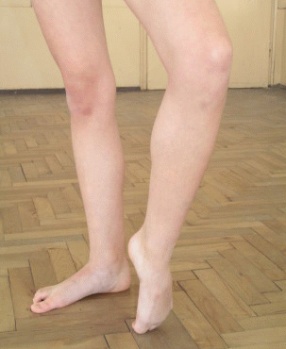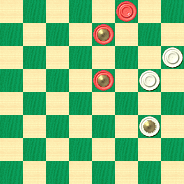The Checker Maven
Jump to navigationSixth Position

Yes, there is in fact a Sixth Position in classical ballet, going literally a step beyond the five positions known to the typical neophyte ballet student, and it's being demonstrated by our ballerina in the photo above.
In a previous Checker School installment about Second Position, we made a similar analogy to dance arts, and in making a like analogy with Sixth Position, we are just as certain as we were in our earlier installment that both ballet's standard positions and checkers' standard positions are quite unfamiliar (to say the least) to the general public.
But we would certainly never dare to lump in our loyal Checker Maven readers with the general public, so we are sure that many of you have at least some familiarity with the Sixth Position of checkers; and today, we challenge you to either demonstrate your mastery, review or relearn an old lesson, or gain new checker knowledge, all depending upon where you currently stand on the scale of checker erudition.
Here, then, is the classic Sixth Position.
A. MACKINTOSH

Black Plays, White Draws
B:W12,16,K24:B3,K7,K15.
Demonstrate how it's done, and when you've finished, click on Read More for the solution, sample games, and detailed notes.![]()
Solution
As is standard for our Checker School entries, the solution, notes, and descriptive text are from Ben Boland's Famous Positions in the Game of Checkers.
7-10---A, 24-20---B, 10-14---C, 20-24, 14-18, 24-27---D, 18-22, 27-32---E, 22-18---F, 32-27, 18-14, 27-24*, 14-10---G, 24-20, 10-7, 20-24, 15-11, 24-20, 11-8, 20-24, 8-4, 24-19, 4-8---H, 19-15, 8-4, 15-19, 7-10, 16-11. Drawn.
Game: 11-15, 21-17, 8-11, 25-21, 9-13, 24-19, 15-24, 28-19, 11-15, 17-14, 15-24, 27-20, 10-17, 21-14, 4-8, 29-25, 8-11, 31-27, 6-10, 25-21, 10-17, 21-14, 1-6, 22-18, 13-17, 27-24, 12-16, 32-28, 6-9, 24-19, 17-21, 19-12, 11-15, 18-11, 7-16, 20-11 9-27, 11-8, 27-31, 26-22, 31-27, 8-4, 5-9, 4-8, 2-7, 22-17, 9-14, 17-10, 7-14, 8-11, 14-17, 11-16, 17-22, 16-20, 27-23, 28-24, 23-27, 24-19, 22-26, 30-23 27-18, 20-24, 21-25, 19-16, 18-15, 24-27, 25-30, 27-31, 30-25, 31-27, 25-22, 27-32, 22-18,32-27, 18-14, 27-24, 14-10, 24-20, 10-7, 20-24. Forms above position. Switcher, Variation 1, Lyman's Problem Book.
Game: 11-15, 22-18, 15-22, 25-18, 12-16, 29-25, 10-14, 25-22, 16-20, 24-19, 6-10, 28-24, 8-11, 19-16, 4-8, 16-12, 11-16, 22-17, 8-11, 17-13, 14-17, 13-6, 2-9, 21-14, 10-17, 23-19, 16-23, 26-19, 9-14, 18-9, 5-14, 32-28, 11-16, 19-15, 7-10, 15-6, 1-10, 27-23, 20-27, 31-24, 16-20, 24-19, 17-22, 19-16, 22-26, 23-19, 26-31, 16-11, 31-27, 11-7, 27-23, 19-16, 10-15, 7-2, 15-18, 30-25, 23-19, 2-6, 19-15, 6-9, 14-17, 9-14, 17-21, 14-23, 21-30, 28-24, 20-27, 23-32, 30-26, 32-27, 26-22, 27-32, 22-18, 32-27, 18-14, 27-24, 14-10, 24-20, 10-7, 20-24. Forms above position, single corner, Variation 2, Lyman's Problem Book.
A---7-2, 24-20*---I, 2-6, 20-24, 3-7, 12-8*, 6-2, 8-4, 15-11, 16-12. Drawn.
B---Forced, or else Black would win by 3-7.
C---If 3-7, 16-11, 15-8, 12-3. Drawn.
D---24-20 loses by 18-22, 20-24, 3-7, 24-20, 15-11. Black Wins. A good rule to note: Stay away from Square 20 and 24 when the Black King on 18 is in White territory, or in their own double corner. When the Black King goes back on either squares 14 or 6 then the White King must go on 24, then if 3-7, 12-8, 15-11, 8-3, the two for two is a good guide for the draw.
E---Here 27-24 loses by 3-7, and if 12-8 or 24-20, then 15-11, Black Wins. The text 27-32 is safest; if 27-31, then 15-19, 16-11* (31-27 loses by 3-7), 19-23, or 24, and White squeezes through for a draw.
F---22-17, 32-27, 17-13---J, 27-32 (27-24 loses by 3-7), 13-9, 32-27, 9-5 (if 9-6 then 27-24 is forced), 27-32, 5-1, 32-27, 1-6, now 27-24*, 6-2, 24-20 is necessary preventing a Black Win by 3-7. Drawn.
G---3-7, 12-8, 14-10, 8-3, 15-11, 24-20, 11-15, 16-11. Drawn.
H---If 7-10, then 16-11. Drawn.
I---24-27 or 24-28 loses by 3-7, 27-24, 15-11, 24-20, 2-6. Black Wins.
J---17-14 forces 27-24 and if 3-7 then 12-8, is a good guide for the two for two to draw.
Sixth Position by Alexander Mackintosh was published as No. 72 in the "Paisley and Renfrewshire Gazette," January 2, 1869. Although this was the first time he published the position, he knew it for some time before.
The Mackintosh Position first appeared in print in "Leeds Weekly Express" Feb. 4, 1865, with Mr. Thomas Lockwood of Leeds, named as its author. Mr. Lockwood did not claim authorship, but expressed his hope that the publication of so beautiful a problem might lead to the discovery of its author.
Lyman in his Problem Book, Position No. 164, gives the author as James Steel, of Kirkconnel.
J. Wyllie said, "the position occurred in one of the match games played between Mr. Steel and myself, at Biggar, in the year 1840."
The History of "Sixth Position" may be found by H. C. Newland, Ph. D., Edmonton, Alberta, in the American Checker Monthly, Jan. - Feb. 1938, Vol. 18.
Editor's Note: We suggest that you practice this position against a strong computer checker program, going over the variations until it's all second (or maybe sixth) nature.
You can email the Webmaster with comments on this article.
